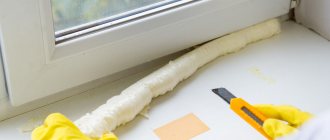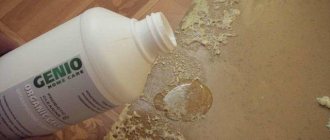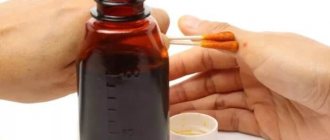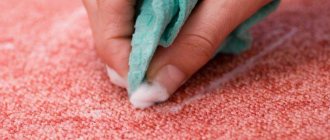Polyurethane foam is widely used for various construction and repair work. It is suitable for sealing cracks, filling openings in windows and doors, gluing building structural elements and household products, and performing a lot of important functions.
Often the work process is accompanied by contact of the sealed composition on various substrates, hands, clothing and hair. What effective means can you quickly remove polyurethane foam in solid and liquid form?
How to get rid of liquid foam on your hands
If foam gets on your skin during work, you must act before it hardens. Semi-liquid sealant is much easier to remove from surfaces than hardened sealant. It is enough to take a clean rag or napkin, wipe your hands, and then wash them well with soap.
If the foam has already begun to harden, you can moisten a napkin with nail polish remover or acetone - such products will quickly dissolve the stain and wash away its remnants.
When washing your hands, you can take a little regular body scrub: its hard particles will help scrub off traces of sealant. After getting rid of the stain, it is recommended to lubricate your hands with a nourishing cream.
Removing foam with alkali and acid - is it possible?
Alkaline solutions are not capable of destroying polyurethane foam - the sealant is resistant to such substances. But if they come into contact with the skin, strong alkalis can seriously damage it and lead to a chemical burn, so it is dangerous to use them. Only soda, which is also a weak alkali, can be used, however, its abrasive properties will play the main role in removing polyurethane foam.
As for acids, their effectiveness in getting rid of polyurethane foam stains is higher, but only in sufficient concentration. For example, vinegar essence (70%) can soften the sealant, but its harm to the skin will be serious, possibly causing a burn. A weak vinegar solution or apple cider vinegar will not have the desired effect, and you should not waste time using them.
Useful tips
In order not to waste a lot of time dealing with the remains of the building mixture on your hands and head, follow the recommendations:
- When working with mounting compounds, use safety glasses, gloves, and cover your head. Clothing must have long sleeves tucked into gloves.
- The components of the polyurethane mixture have an aggressive effect on the skin of the hands and head, so after cleansing, be sure to treat the area with a regenerating and softening agent.
- Try to use the same brand of solvent as the mortar. They handle it better.
- When carrying out work, prepare a clean rag in advance to remove excess composition.
Methods for removing hardened foam
If it was not possible to get rid of the liquid product and the stains went unnoticed, you will have to use more effective methods for cleaning the skin of your hands.
Special aerosols
Many sealant or paint manufacturers produce special cleaners in aerosol form. You can buy a can along with foam so that you don’t have any problems cleaning your hands or other surfaces. Also, with the help of aerosol solvents, it will be possible to remove the mounting foam from the gun, which gets the sealant on it even more often. It is better to buy an aerosol of the same brand with foam - the cleaning efficiency will be higher.
Liquid solvents
Organic solvents should be used with caution. They do not cause burns, but they dry out the skin greatly, so contact with hands or other areas should be as short as possible. After cleansing the skin, wash your hands with soap and apply nourishing cream.
Kerosene, gasoline, acetone and white spirit
Any organic solvent can remove a sealant stain, because most installation products contain such substances and harden only after they evaporate. It is best to use acetone or nail polish remover - they are more gentle on the skin.
Stubborn stains should be removed with gasoline or kerosene, moistening a cloth and applying it to your hand for 5-10 minutes. After softening, you need to wash the composition, if necessary, using a body scrub. All solvents emit an unpleasant odor, their fumes are harmful to health, so you need to work with them in a well-ventilated area.
Traditional methods
Unconventional methods of cleaning hands from polyurethane foam are used when solvents are not available. Those that involve the use of food products are the safest, suitable even for children and allergy sufferers.
Vegetable oil
Before use, the vegetable oil must be heated until it is warm (about +40 degrees). Then apply to a cotton pad or bandage folded in three and apply to the contaminated area of skin. After 10 minutes, the sealant will soften and can be wiped off mechanically or washed off with plain water and soap. To be sure to get rid of the stain, you can rub your hands with dishwashing liquid after the oil.
Salt
Salt serves as an excellent abrasive that quickly cleanses the skin of your hands of any impurities. A small stain can simply be rubbed off with salt using vigorous movements. If the polyurethane foam has become ingrained and cannot be removed, the actions should be as follows:
- take a liter of hot water;
- add a tablespoon of salt, dissolve it;
- place your hand in the solution, hold for a couple of minutes until the skin steams;
- remove the stain using coarse salt or scrub.
"Dimexide"
This drug is sold in any pharmacy and is inexpensive. It perfectly removes contamination from sealant, paint, and other building compounds. It is only important not to use Dimexide undiluted, as it can cause burns . You need to add water to the product in a 1:1 ratio, then wipe your hands with a cotton swab or cloth. If signs of an allergic reaction appear, the skin should be immediately washed with soap.
Mechanical methods
Mechanical cleaning can damage the skin if not done carefully. Therefore, it is advisable to use any abrasives (scrub, salt), brushes and pumice stones after preliminary steaming of your hands. It is enough to hold them for 5 minutes in hot water - in a bath, under the tap. Afterwards, the skin should be lubricated with a rich cream, oil, then begin to rub off the stain. Another option for safe hand cleansing is to use an abrasive on soapy skin. Do not use a knife, scissors, or metal scrapers - this can cause injury and infection!
First aid for skin, hair and things
Polyurethane foam easily adheres to any surface. And this applies not only to doors, glass, floors, walls. The sealant tends to stick to a strand that has escaped from under the scarf or to an accidentally exposed elbow. And there’s no point in talking about clothes; drops of foam will definitely appear on them. What to do in these situations? Experts recommend using the following methods.
Let's wash our hands
Peculiarities . The hardest thing is to remove foam from the surface of the skin. Most chemicals that have the ability to dissolve sealants are strictly contraindicated for washing the skin. To properly wash foam from your hands, use a simple algorithm.
- Prepare a warm solution by adding salt to the water: approximately two tablespoons per liter.
- Place your hands in the bath and wait about 30-35 minutes. The saline solution will soften the foam.
- Apply a rich cream or vegetable oil to the problem area.
- Armed with a pumice stone, wipe off the sealant, being careful not to scratch the skin.
- The remaining small stain on the hands can be easily washed off with regular water and soap within two to three days.
Saving a hairstyle
Peculiarities . It is not possible to completely wash your hair. Strands exposed to the sealant will have to be cut off. That is why work in a scarf or a hat. If you are ready to fight for your hair, you can try the following method.
- Pour the drug "Dimexide" (diluted) onto a gauze napkin.
- Thoroughly wipe the affected strands with it.
- Reviews indicate that the procedure must be repeated several times until all the sealant is removed from the hair.
- After such aggressive exposure, rinse your hair thoroughly with a mild and nourishing shampoo.
We reanimate clothes
Peculiarities . If clothing is damaged, you can resort to the temperature method, which involves freezing.
- Place the product in a plastic bag.
- Place it in the freezer.
- Leave for eight to ten hours.
- Remove from the freezer and unwrap the fabric.
- Carefully remove the mounting foam from the product.
- Be sure to wash the item as usual.
There are many effective methods that allow you to quickly wash dried polyurethane foam. But if you are not in a hurry, you can use another, very effective method for cleaning clothes. Hang the fabric outside, exposing the sealant stain directly to the scorching rays of the sun. Periodically knead the product with your hands. Then soak the clothes in hot water with the powder. This method will not only remove polyurethane foam, but also completely discolor the stain.
Cleaning different surfaces
Spray foam stains can also form on materials, products, and parts that are being worked on. If you use aggressive methods, the finish will deteriorate, because chemicals corrode the protective coating.
Laminate and linoleum
The top layer of foam should be cut off as much as possible with a sharp stationery knife, acting carefully so as not to scratch the floor covering. Afterwards, you need to take a solvent (except acetone), moisten a rag or sponge with it, and apply it to the floor for 5 minutes. Clean any remaining foam with a stiff plastic brush.
Nail polish remover should not be used for this purpose - it, like acetone, leaves dull white spots on the coatings.
Carpets
It happens that foam hardens on carpet, artificial or woolen carpets. You can remove it from such materials with acetone or Dimexide. Use a sponge or rag soaked in solvent to wipe off the mounting foam, and then wash the area of contamination with special detergents (for example, “Vanish”).
Doors
If the sealant has hardened on doors made of veneer, wood, or MDF, you can use Dimexide, a soap solution and a soft brush or sponge. The procedure is quite labor-intensive, because strong pressure and friction leave stains and scratches on the doors. Upon completion of treatment, the solution containing foam particles must be washed off. After such manipulations, lightened areas are often revealed on a varnished door, so the canvas has to be coated with a new layer of varnish.
Window
Plastic surfaces can be cleaned of any dirt using specialized products (for example, Cosmofen). They contain powerful plastic-friendly solvents that remove traces of foam without leaving any residue. The only disadvantage of such funds is the high price. Fresh foam stains can be removed with a regular wet sponge, but you must act quickly before the sealant sets.
In order not to damage the top layer of plastic, which in the future will lead to a deterioration in the appearance of the window and its regular contamination, you should not use hard brushes or coarse abrasives. Cleaning powders also cause plastic deterioration. It is better to carefully cut off a thick layer of foam with a knife, and then use one of the following methods:
- heat vegetable oil, apply generously to the stain, remove any remaining dirt with a brush after half an hour;
- pour hot water over the stain, place a rag on top, after 10 minutes carefully wipe off the foam with Dimexide;
- Mix solvent 646 and acetone in equal parts, treat the surface of the window, then finally remove the foam and wash the plastic with soapy water.
Recommendations from experts
Experienced builders know how to remove residual material from various surfaces, and do it carefully and efficiently.
Let's consider the main recommendations:
- Do not try to wash off the frozen foam with water, because it will only help it harden and expand even more.
- Do not use blades or powders on surfaces that are not scratch resistant.
- The use of solvents to clean varnished or painted surfaces is under no circumstances permitted. This is because unpleasant white spots may remain, and they cannot be removed.
- Do not spread fresh sealant onto the fabric material, as this will only cause more stains.
Wooden materials are very difficult to clean, so it is best to sand it using paints and varnishes. Pre-clean the coating with sandpaper.
Removing foam from clothes
It is quite difficult to wash off foam from fabric without damaging it. You can wipe the affected area with white spirit, purified gasoline, and acetone. Organic solvents can leave lightened stains on clothing, so it is better to try the procedure on an inconspicuous area.
Contaminated fabric can be cleaned mechanically by cutting off layers of foam with scissors or a knife. Afterwards, lather with laundry soap, washing powder, and wash the stained area by hand. Delicate fabrics are unlikely to be damaged, so it is better to work with polyurethane foam in old, unnecessary clothes or work kit.
How to remove with special compounds?
There are compositions on sale that can be used to safely and effectively remove polyurethane foam. They can be purchased at construction stores or ordered on the Internet market. Top 3 best products:
Tytan Eco Cleaner
A product for removing fresh foam from various surfaces . The basis of the cleaning composition is solvents. The liquid can be used to treat clothing, glass, plastic and metal products. Price for 500 ml – 450 rubles.
Hauser
The universal composition is intended for treating surfaces made of different materials. Price for 360 g – 300 rubles.











